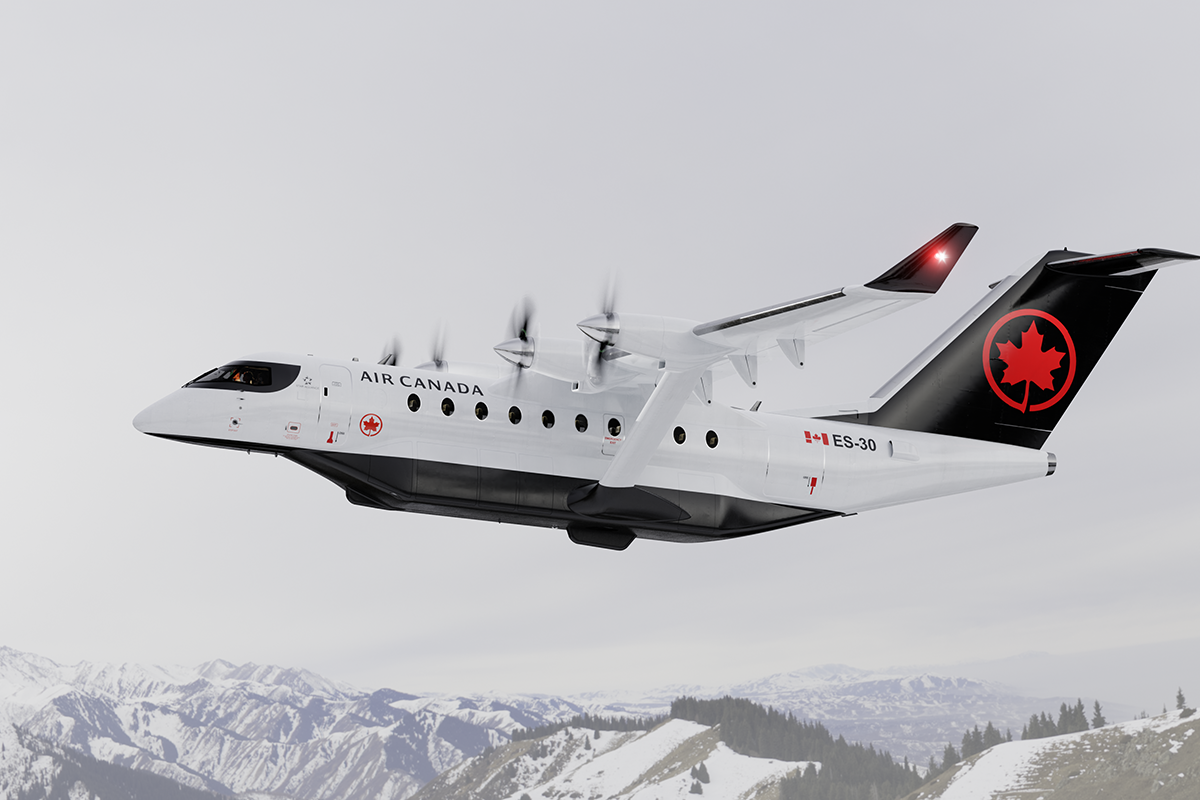Will a Larger Airframe Help Heart’s Electric Airplane Become a Reality?
Air Canada and Saab join growing list of backers for Heart Aerospace’s environmentally friendly regional airplane.

Air Canada has invested $5 million in Heart Aerospace’s ES-30 electric airliner program and signed a provisional agreement to buy 30 aircraft. [Courtesy: Heart Aerospace]
Now that Heart Aerospace has announced plans to develop a 30-passenger electric airplane instead of a 19-passenger platform, the Sweden-based company may be on a more likely path to success.
Heart announced Thursday it will abandon previous plans to develop its ES-19 in favor of a larger, battery-powered electric regional aircraft design called the ES-30, which incorporates a non-electric power source for reserve range— two turbogenerators that burn sustainable aviation fuel (SAF).
“The 19-seat version was an interesting experiment, but 19-seat planes have absolutely zero relevance in the airline industry,” said aviation industry analyst Richard Aboulafia, a managing director at AeroDynamic Advisory, a boutique aerospace and defense management consultancy.
Heart CEO Anders Forslund put it somewhat bluntly in a press release: “The ES-30 is an electric airplane that the industry can actually use.”
It also doesn’t hurt Heart’s prospects that Air Canada and Saab have signed on to the ES-30. Thursday’s announcement included the news that Canada’s flagship carrier has provisionally agreed to buy 30 ES-30s. Saab, well-known for its background in military aviation and automobile production, was founded in Sweden and has roots stretching back to the early days of powered flight. Each company has agreed to invest $5 million to develop ES-30.
Aboulafia said the two familiar brands represent a “solid endorsement,” but “It’s hard to tell what’s for advertising these days and what’s a real investment for the future.”
Heart and other aircraft developers are a part of the worldwide push throughout the aviation industry to find environmentally friendlier propulsion systems.
Globally, civil aviation produces about 2.1 percent of all human-induced CO2 emissions, according to the Air Transport Action Group. Government and airline initiatives aimed at reaching net-zero emissions are helping to drive development of electric and hybrid electric platforms.
‘It’s Hard To Know’
Under electric power, the ES-30 is expected to offer a range of 200 km (108 nm), and with the SAF-burning reserve, an extended range of 400 km (216 nm) with 30 passengers, Heart said. With 25 passengers, range expectations increase to up to 800 km (432 nm).
“The reserve-hybrid system is installed to secure reserve energy requirements without cannibalizing battery range,” Heart said. “It can also be used during cruise on longer flights to complement the electrical power provided by the batteries.”
Aboulafia said he has “always been more comfortable with hybrids than I have with batteries. You have to carry an awful lot of battery by weight in order to go anywhere, with anything on board. Hybrid always offers a better way forward.”
But a big question surrounding the ES-30’s propulsion system “is whether all of this onboard equipment pays its way in terms of real estate.” As Aboulafia put it, “Without detailed technical assessments, it’s hard to know.”
Orders for Heart’s previously planned electric airliner—ES-19—including those from United Airlines and Mesa Air Group, have been reconfirmed for the ES-30, Heart said. Those orders amounted to 200 aircraft purchases with options for an additional 100. Also, Heart said “many” potential customers who had signed letters of intent (LOIs) for the ES-19 have updated those LOIs to reflect the ES-30.
“In total, Heart Aerospace has LOIs for 96 ES-30s,” the company said.
Heart’s surprise redesign brings to mind Boom Aerospace’s unveiling in July of a new design for its Overture supersonic passenger jet.
Heart’s redesign “appears to have some actual science behind it, whereas Boom’s appears to just be a playful session of freehand drawing,” Aboulafia quipped. The announcement had a “complete lack of explanation for why Boom was moving to a four-jet configuration without any reference to engines whatsoever.”
Last year, Heart said the smaller ES-19 was expected to make its first flight in 2024, and enter service in 2026, pending certification.
Now, as Heart moves forward with its larger design, the company said it expects the ES-30 to enter service in 2028.

Subscribe to Our Newsletter
Get the latest FLYING stories delivered directly to your inbox






